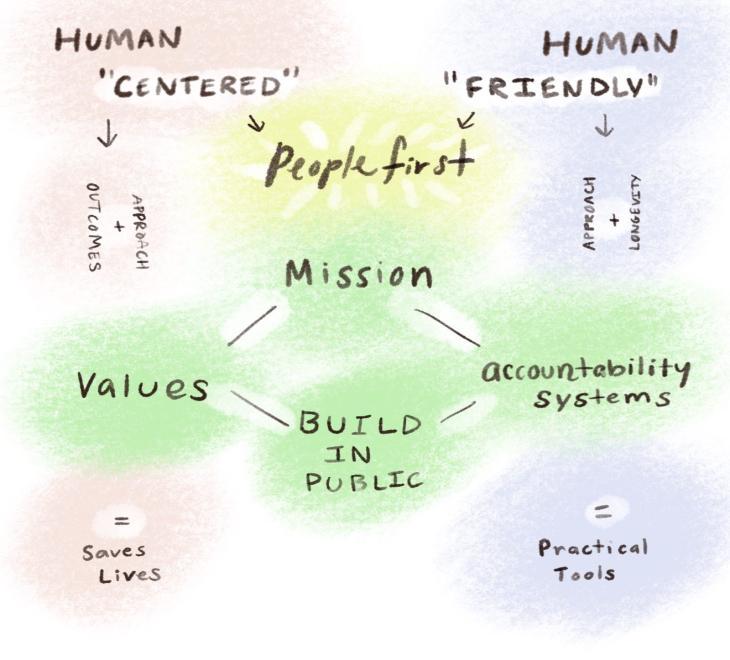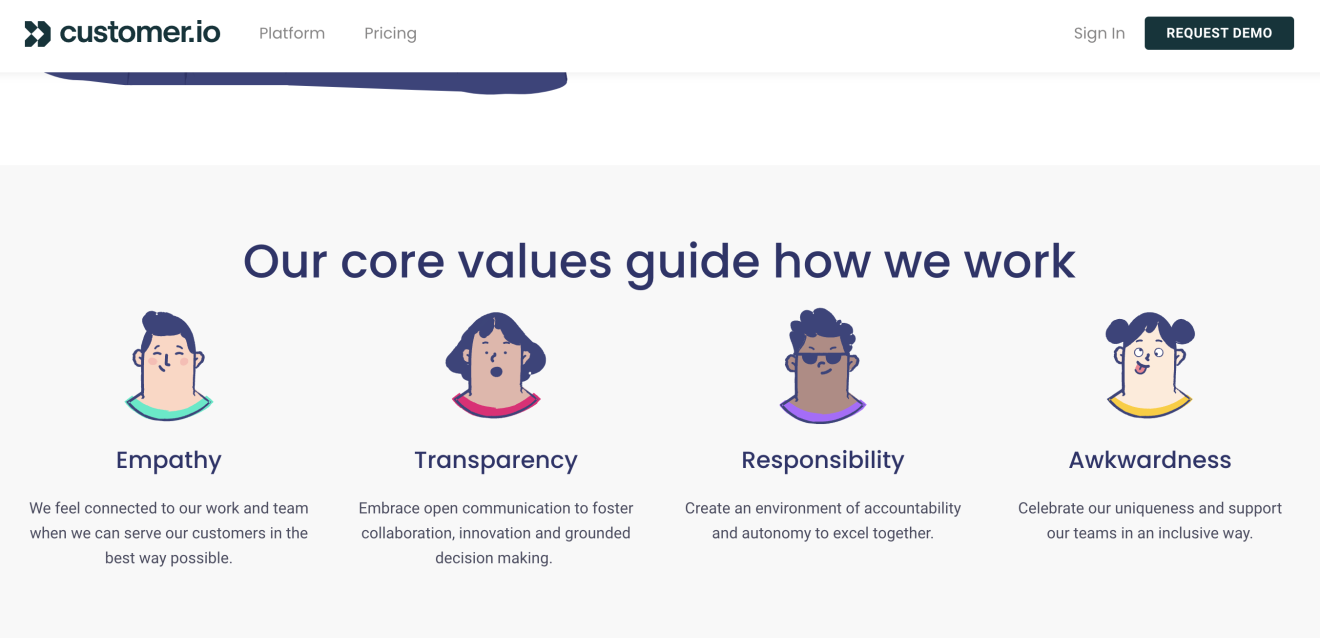A business model is a major indicator of what to expect from a company or its product. However, it is subject to change over time, usually due to a lack of profit. The company’s values will shape how the business model changes if it can at all.
The company’s values are potentially even more telling of what the company and its products will become. This is especially true if the company has also implemented accountability systems.
For reference, I created this graphic to illustrate concepts I’ll be discussing in this post.
It reflects my views on human-centered and human-friendly technology; specifically how they relate to one another and good company values, business models, and accountability systems.

First, a company’s business model determines its actions and decisions, regardless of the preferences of its leadership or employees.
Early in my career, I worked for a company specializing in financial underwriting for consumer goods, but I did not find it very ethical. The people I worked with were awesome. For one, it was a great place to grow my skills. In part because leadership made a lot of effort to invest in our career growth and was not hesitant to promote hard workers. However, I think the flaw was just the nature of the loan industry, particularly around frivolous consumer goods.
After that, I wanted to work for places where the end product was “good for people” at best and not harmful at worst. However, I caution that “good causes” can be used as marketing instruments to attract customers and talent. They may never actually deliver on their claims. Alternatively, they may misrepresent how exactly they help the cause.
Unfortunately, even assuming only the best intentions of its creators, the business model could have underlying issues. Due to financial tetherings and risk, it may be difficult for a company to change it, even if they want to. This is especially true when there are commitments to investors like friends and family, private equity firms, and employees’ livelihoods to consider.
Across industries, there are examples of business model issues that are difficult to fix once established.
For example:
- In the financial underwriting business, there was no incentive to refuse to loan money to people if it would be profitable for the company. Rejections happen when there’s a risk the company will lose money.
- In lead-gen businesses, the largest accounts support most business expenses (like expensive labor), so it might not matter who is buying, even if the staff questions clients’ ethics and the company has systems for reporting them.
- In digital agencies, the profit margin is made by reducing labor costs (where typically you are the labor!).
- If reading this made you think of some others, feel free to share them with me. We can chat about it, or I can add it to this list with permission!
Of course, this doesn’t mean you can’t work for companies with imperfect business models. In fact, you can probably find something wrong with almost any business model.
Secondly, you can look at the company’s mission and values. However, you should look for accountability systems and evidence they are truly guided by them.
Company mission and values can be shallow, so I like to look for accountability systems or evidence that the company has been truly guided by them.
If these systems are in place, then there has been and will be infrastructure for the company to change. That means the values will have shaped the business model and other critical strategies.
Values will continue to indicate the company’s direction and decisions, even more so than the business model.
Additionally, when values can be trusted, the mission can be seen as achievable and accurately guides the future.
For example, if a company values sustainability or long-term investment, it probably made better foundational decisions, like spending the time to figure out product-market fit, devise an effective distribution plan, and hire and retain top talent. These values will have guided the development and discovery of the business model and other critical strategies to make the company successful.
Additionally, I think the company values should align with your own.
I look for company values that include transparency, curiosity, empathy, diverse thinking, and unique values, too.

It’s nice to see a company with its own unique value to offer. These unique values tend to reveal some communal lore, competitive advantage, or lessons learned along the way. Per the screenshot above, Customer.io’s unique value is “awkwardness” and is further described: “Celebrate our uniqueness and support our teams in an inclusive way.”
To me, it shows that a company is in it for the long haul if it is willing to establish a set of values and a system for ensuring they are lived by.
Building in public – a new trend for making technology transparent and a good example of an “accountability system”.
So what’s an example of an accountability system? Building in public!
A trend for many who have amassed software skills, “building in public” is a concept of sharing the behind-the-scenes of how that is built. Getting transparent about how technology is built is for anyone, really, from solopreneurs to established organizations.
For example, some companies (e.g., PostHog) will post their entire company handbook online. Others will blog about their product roadmap, share their engineering blog, etc. – the actual product builders themselves will share their discoveries and accomplishments along the journey to building the product.
Some companies are not labeling it “building in public,” but they are kind of doing it.
For example, Hubspot writes extensively about what engineering is up to and what’s on its roadmap. I dug up this HubSpot community AMA from a few years ago, where one participant asked:
“Isn’t this inherently risky? This gives up our playbook. Considering we’re a small team that can get outspent and outexecuted, wouldn’t this put us at a disadvantage?”
The response in the AMA acknowledged the risk but said that the benefit of customers being happier with more transparency into the company’s roadmap and overall vision was worth it.
Do you know any companies publishing their process publicly? Write about it and tell me! 👇
Instead of traditional comments, I encourage you to respond with blog posts, videos, or other digital creations on your own space (read why here).
👉 Share your response by posting a url to contribute to the evolving conversation section, which also includes prompts to inspire you.
Being dedicated to transparency is difficult to “pull off” if it’s not real.
Since transparency around how the product is built creates room for feedback, it ensures continuous improvement from the feedback it inevitably receives. I think it would be hard for companies to stay in business if they responded poorly to that feedback. The AMA seemed to think that being transparent helped set customer expectations.
Sometimes, the business model changes and ruins the product’s quality. This is because it is not profitable.
It has been common to build products without profit to gain users, distribute with virality, and ensure heavy dependency. The idea is to figure out the business model afterward, which almost always means advertising to users whose data has been processed for targeted marketing.
Additionally, building a high-quality product that is free and subsidized by investors inflates people’s expectations.
It incorrectly teaches people that products like this are not costly, which could not be more wrong!
An example of this kind of product might be Instagram, which started as a beloved hobbyist platform (I love hobbyist platforms!) for photographers and creatives to post images in galleries. It’s become a marketing engine of short video content filled with ads.
Considering how many people use it and the costs to run it, I am not sure I totally blame them—but if there had been values in place and systems to enforce them, that might not have happened.
What do you think of platforms like this? Those that are subsidized by investors or selling your data? Do you still use them? See all my prompts for this piece or join the conversation, here.


